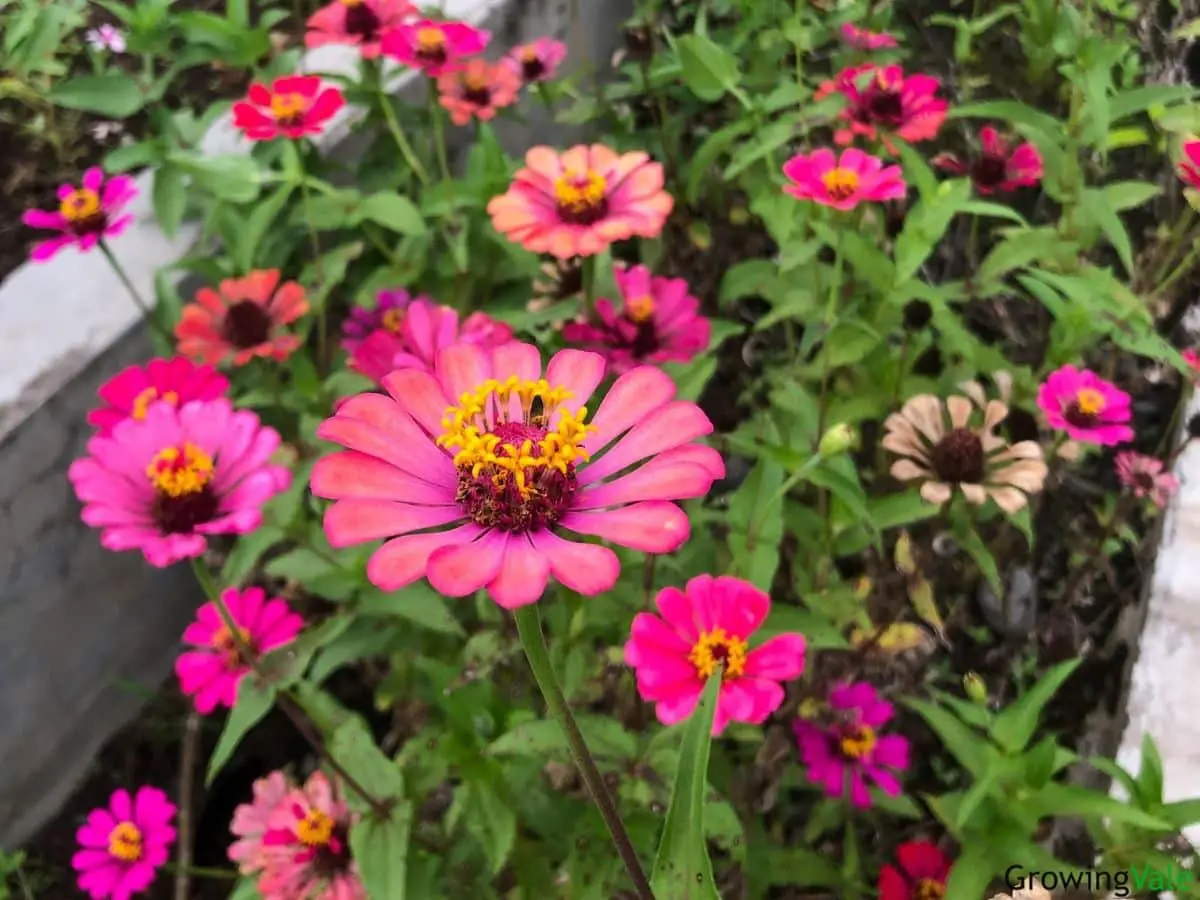Zinnias are delightful flowering plants that belong to the genus Zinnia! They are extremely popular as summer bedding plants worldwide, with around 22 species within the genus.
Of these, several have been highly cultivated, especially Zinnia elegans, or the common zinnia! Zinnia flowers can be annuals, perennials, or subshrubs, but most garden varieties are half-hardy annuals.
These wonderful plants are favorites for mixed beds and borders, but also look at home in cottage-style, informal, and courtyard gardens! They can be grown in containers, so are fantastic choices for adding a bright splash of color in patios or balconies. Zinnia plants are great cut flowers too, making them well-loved for cutting gardens.
History
Zinnias are native primarily to Mexico, with their outer reach expanding to the southwestern U.S. and parts of Central and South America. They are said to have been cultivated as early as 1520 by the Aztecs, but these plants would look very different from modern-day zinnias due to extensive breeding!
Their genus name Zinnia was named in honor of Johann Gottfried Zinn (1727-1759) a German anatomist and botanist who allegedly collected the first zinnia seeds in Mexico when he was confronted by bandits. Zinnia plants have come a long way since then and were the first flower to be grown in space aboard the International Space Station (ISS) in 2016!
Zinnias have long-lasting, showy blooms that come in an amazing variety of colors and forms! Their flowers can be single, semi-double, or double, and come in different shapes such as pompom, cactus, and dahlia-flowered. They come in vivid shades of white, pink, red, orange, yellow, purple, and can be bi-colored too!
Plant Facts
| Scientific name | Zinnia spp. |
| Common names | Zinnia |
| Genus | Zinnia |
| Family | Asteraceae |
| Height | 0 ft. 6 in. – 4 ft. 0 in. |
| Width | 0 ft. 6 in. – 1 ft. 6 in. |
| USDA Plant Hardiness Zone | 2 – 11 |
| Origin | Southwestern U.S., Mexico, Central America, and South America |
| Flower colors | White, Pink, Red, Purple, Yellow, Orange, Multi-colored |
| Blooming season | Summer, Fall |
| Plant/Flower special features | Bright and colorful flowers |
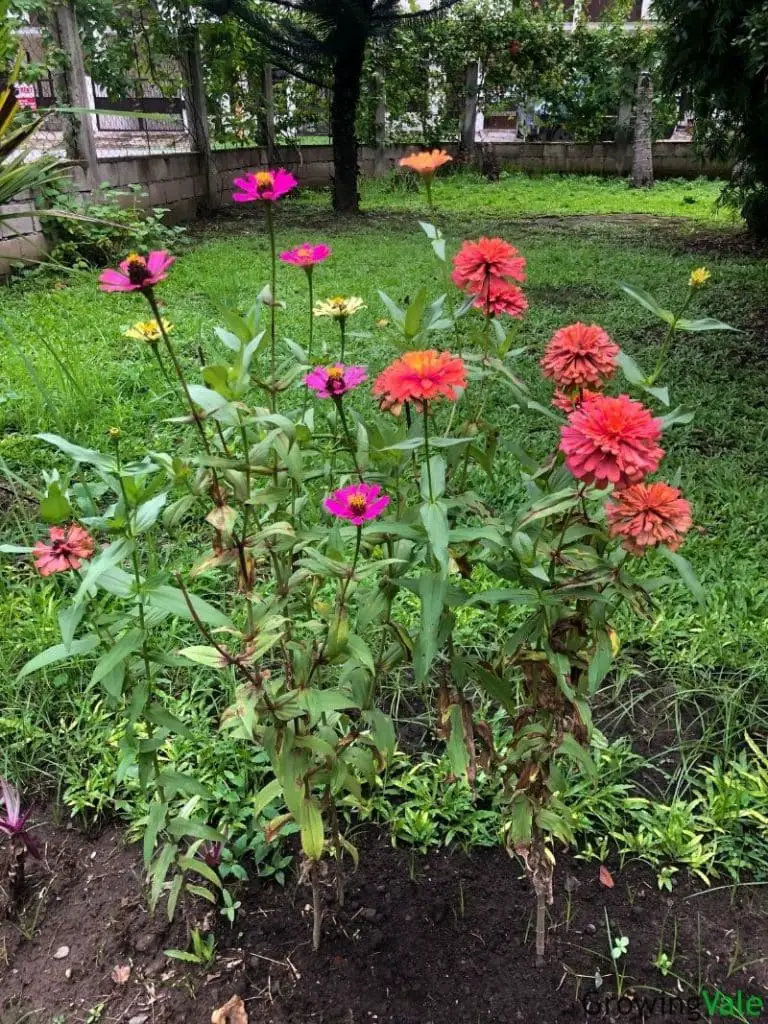
How to Plant and Grow Zinnias
Zinnias are easy-to-grow plants that are often recommended for beginners and those wishing to pursue gardening with their children! They can be sown directly from seed in late spring, once the risk of frost has passed or young plants can be transplanted out for a head start on the blooming season.
Growing Zinnia Flowers in Beds
To grow zinnias in beds, first, make sure the seedlings have been hardened off. Once the threat of frost is over, prepare the site by removing any weeds and breaking up the soil using a rake or hand trowel. Remove any large stones in the process.
Dig a hole as deep as, and twice as wide as the root ball. Carefully tease the plants out of their container, making sure to not disturb or damage any roots as zinnias are a little fussy. Place the root ball into the hole with the top of the roots just below the surface of the ground, then fill in with soil. Gently firm the ground around the zinnia and water well. Space plants at least 12 inches apart.
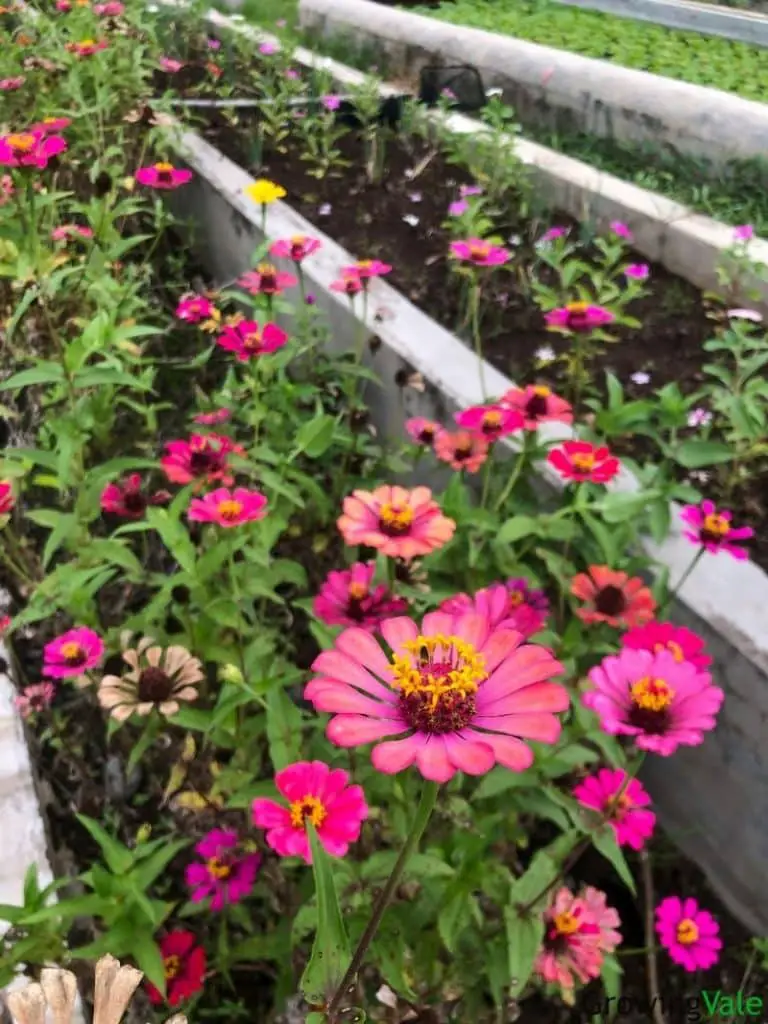
Growing Zinnia Flowers in Containers
Zinnias can be successfully grown in containers! Choose a large pot with plenty of drainage holes and fill it with a well-draining potting mix. Either sow seeds directly in the pot or transplant seedlings started indoors.
It may be tempting to sow or plant the zinnias closer together for a pretty display but bear in mind that overcrowding and high humidity will increase their chances of developing some diseases.

How to Propagate Zinnias
Zinnias are easily propagated from seeds. Seeds can be saved from previous years or are easily purchased online and in nurseries! These plants do not like their roots to be disturbed, so when sowing them directly onto the ground, make sure this will be their final spot!
Sowing Zinnia Seeds Directly Outdoors
If sowing zinnia seeds directly outdoors, sow seeds in late spring after the threat of frost has passed. Select a sunny planting area that will meet the plant’s needs. First, weed the area either by hand or using a trowel. Then, use a rake to break up the soil and remove any large lumps of soil or large stones.
Either scatter the seeds directly on the ground or sow the seeds in drills. For the scatter method, scatter the seeds evenly and thinly on the ground, firm them into the soil, then put a light layer of soil on top. Water them with a watering can with a rose head attachment to avoid dislodging the seeds.
To sow the seeds in drills, create a shallow drill using a stick or trowel. It may be better to create a waved drill rather than a conventional straight drill for a more “wildflower garden” look. Pour a small amount of water into the drill and place the seeds inside at an even distance. Cover with soil and firm the ground gently before watering with a watering can fitted with a rose sprinkler head.
Keep the soil moist and weed the area every few weeks to remove any competition from weeds. Thin out the seedlings once they’re established to create good air circulation between plants.
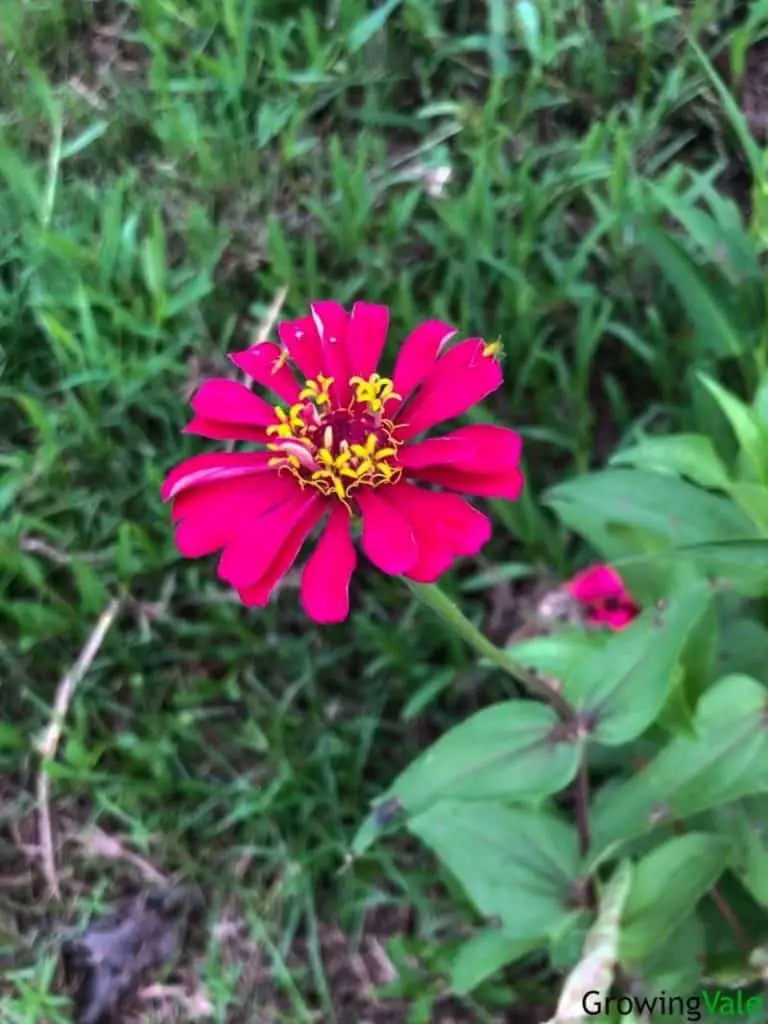
Sowing Zinnia Seeds Indoors
Some gardeners prefer to sow their zinnia seeds indoors in early spring ready for planting out in late spring to get an early start to the blooming season! To do this, fill a seed tray or modules with seed mix and press the zinnia seeds gently into the compost to firm them, spacing them out as directed on the seed packet.
Cover the seeds with a light layer of compost unless directed otherwise on the packet, and sprinkle some water on top using a watering can with a rose head attachment. Either cover the tray with a clear plastic bag and place it in a bright, warm area out of direct sunlight or place the tray in a propagator with a temperature of 64°F in an area that gets indirect light.
Keep the compost moist and within 2-3 weeks the zinnia seeds should have germinated. At this stage, remove the propagator lid or plastic bag and keep the seedlings watered with plenty of sunlight. Once their true leaves have grown, prick them out of the tray and plant them in small individual pots.
Once the threat of frost is over and the seedlings are strong, begin hardening them off 10-14 days before transplanting by slowly introducing them outdoors. First in a shady spot for a few hours a day, gradually increasing it to the whole day, then toward the end of the two weeks, leaving them out overnight. After this, they will be ready for transplanting outdoors.
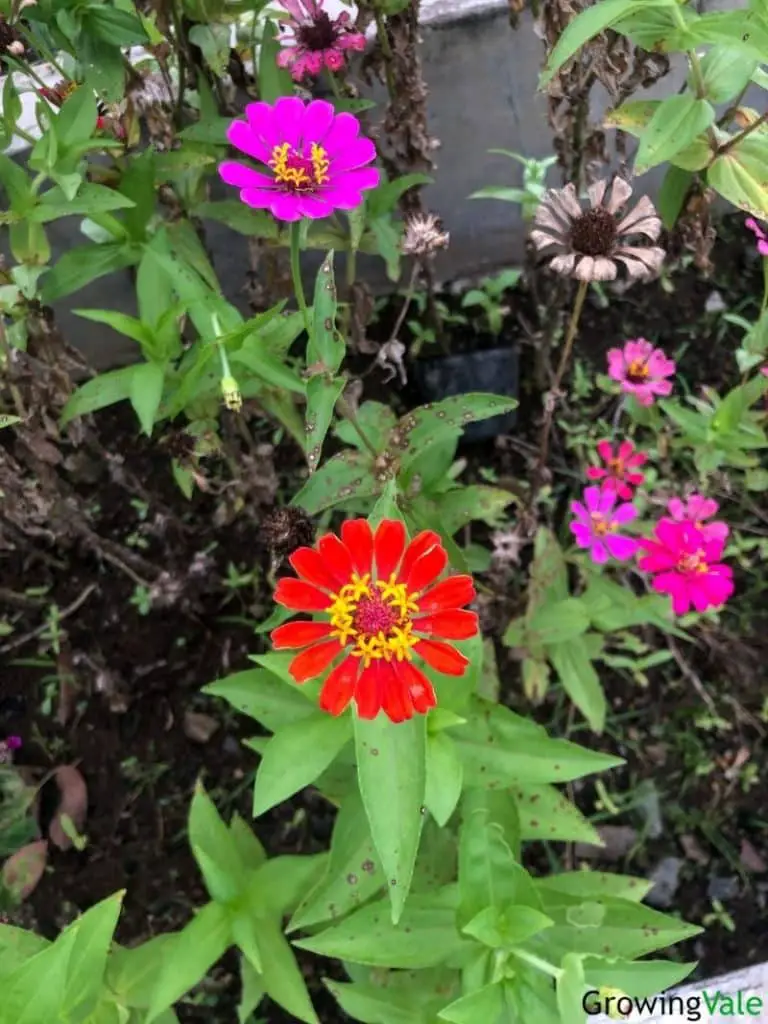
Care and Maintenance
Here are some useful tips on how to care for your zinnia plants:
Soil
Zinnias are low-maintenance plants that prefer to be grown in humusy, moist, well-draining soils. However, they aren’t fussy and can grow in loamy, chalky, sandy, or clay soils that are neutral, acidic, or alkaline, as long as they are well-draining!
Water
Water zinnia plants when needed. They are low-maintenance, drought-tolerant plants but they will benefit from regular watering over the growing season (every 5-7 days). However, they may suffer from powdery mildew and other diseases if over-watered.
Those grown in containers will dry out considerably quicker, so may need watering more often.
Fertilizer
Zinnia flowers don’t need to be fertilized regularly and don’t require mulching, but they may benefit from occasional feeding from a well-balanced mix following the package instructions.
Sunlight
These plants adore the sun and should be planted in an area that receives at least 6 hours or more of direct sunlight a day.
Temperature and Humidity
Zinnias absolutely love the summer heat, but in humid conditions, they can become more susceptible to diseases like powdery mildew. Spacing them apart is especially important in humid climates!
Pest and diseases
They are generally trouble-free when it comes to pests, but some to look out for are Japanese beetles, whiteflies, aphids, thrips, and caterpillars.
Unfortunately, zinnia plants are quite susceptible to powdery mildew, fungal leaf spots, and grey mold. So it is important to leave plenty of space between plants to allow for air circulation and to water the base of the plants and avoid getting the foliage and flowers wet.
Grey mold or Botrytis cinerea can wreak havoc in humid conditions and can spread rapidly, it is easily recognized by the fuzzy, gray-brown mold found growing on the decaying flowers, buds, and leaves of the plant. It can also present as small seed-like structures which are harder to spot. If spotted, remove any dead and dying plant parts and dispose of them immediately.
Pruning
Zinnias don’t require any pruning, and some cultivars are even self-cleaning, making them even more low-maintenance! However, deadheading spent flowers can help to encourage a rebloom.
It is also possible to pinch back the stems of younger plants to promote branching unless long-stemmed plants are desired.
Uses of Zinnias
With their vividly-colored flowers and long blooming period, zinnia plants are firm-favorites for summer bedding schemes! They are highly attractive to butterflies, making them a great choice for pollinator gardens. Their flowers also provide nectar to hummingbirds, and in some areas, their seeds are a source of food for songbirds.
Zinnias have long-lasting and showy flowers, so are a favorite for cut flowers!
Common Varieties and Cultivars
There are so many delightful types of zinnias to choose from with a range of colors, heights, and forms! Below is a list of some of the most popular zinnia species and cultivars:
- Z. elegans – Also known as the common zinnia, this lovely flower is a favorite for sunny borders! They are annuals that grow between 1 and 3 feet tall depending on variety and suit several garden styles, including cottage, informal, and city gardens.
- Z. elegans “Dreamland Red” – Dreamland Red is a member of the Dreamland series and a bold addition to any garden! It has fully-double, rich red flowers that grow as wide as 4 inches. Its compact height of 1 foot makes it a strong candidate for container and patio gardens!
- Z. elegans “Zowie! Yellow Flame” – This sunny zinnia variety has beautiful semi-double, bi-colored flowers! Its petals are dark pink to red at the base and change to a bright golden yellow at the tips. It has a dark red central eye that gets decorated with tiny golden starry blooms as the flower matures.
- Z. haageana “Aztec Orange” – Aztec Orange is a compact zinnia plant that grows as tall as 16 inches. It produces numerous small, semi-double, and fully double flowers from early summer through to the first frosts. These flowers are a vibrant red with contrasting sunshine yellow tips and a dark red central eye that becomes adored with starry yellow flowers with maturity.
- Z. peruviana – Also referred to as the Peruvian zinnia, this lovely plant has daisy-like flowers that come in rich shades of pink, red, orange, and yellow! This variety looks fantastic in the beds and borders of both cottage-style and tropical gardens.
Conclusion
Zinnias are beautiful flowering plants of the genus Zinnia. There are roughly 22 species in the genus, several of which have been highly cultivated to produce a wide selection of colorful flowers with lovely flower forms! Of these, Z. elegans is very popular, and like most garden zinnias, is a half-hardy or warm-season annual.
They are easily grown from seeds and can either be sowed directly into the ground or started indoors to get a head start on the blooming season. These low-maintenance plants are wonderful for beginner gardeners or for introducing children to gardening. They prefer full sun conditions and can grow easily in a variety of soil types as long as it is well-draining.
Zinnia flowers are brightly-colored and come in a range of shades such as white, pink, red, purple, yellow, orange, and can even be bi-colored! They can be single, double, or semi-double, and have many forms including cactus, dahlia-flowered, or pompom.
These sunny flowers are perfect for bringing a pop of color to cottage-style, informal, and courtyard beds and borders, as well as container gardens and patios!
Check our blog post about zinnia flower meaning to learn more fascinating things about this flower.

